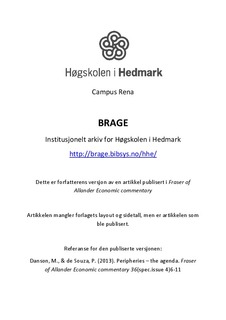| dc.description.abstract | Fra første side: According to analysis for the uropean Commission, three of the four leaders in innovation in the European Union are the Nordic countries of Denmark, Finland and Sweden – Germany being the other (Innovation Union Scoreboard, http://ec.europa.eu/enterprise/policies/innovation/facts-figuresanalysis/innovation-scoreboard/index_en.htm).
Confirming this tendency to modernity and adaptation to the demands of a globalised marketplace, in a similar pan-European study, it has been observed that there are:
“economically successful regions with below average accessibility. Often ... sparsely populated and remote ... in the Nordic Countries, north-east of Spain, Scotland, Ireland and in and around northern Italy. ... Regions in the Nordic Countries, for example, have overcome their peripheral location by capitalising on current strengths in relation to ICT, research, educational and environmental opportunities and less on improving their accessibility”. ESPON (2010), New Evidence on Smart, Sustainable and Inclusive Territories. Polycentric Europe: smart, connected places, First ESPON 2013 Synthesis
Report.
http://www.espon.eu/export/sites/default/Documents/Publications/SynthesisReport/FirstOctober10/fullversion.pdf).
Contributions to the book on Regional Development in Northern Europe : Peripherality, Marginality and Border Issues,( edited by Mike Danson and Peter de Souza, published February 2012, Routledge) include chapters which extend this particular research theme by focusing on specific regions, especially in
Scotland and Norway. Around the former, Davies et al. (2012) provide positive answers to the question of “Can peripheral regions innovate?” while in the Norwegian context Bergum (2012) discusses “Proximity and distributed innovations. Innovations ‘in the shadow of the clusters’’ revealing that, indeed, the ESPON and CEC findings are transparent on the ground. | no_NO |
